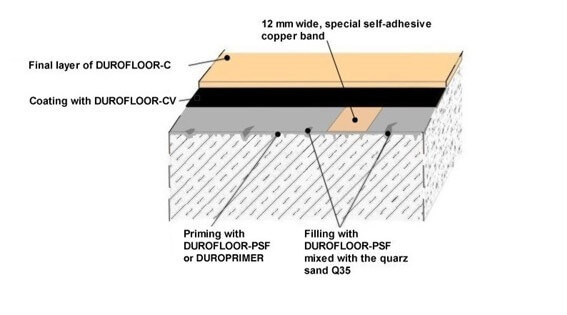Construction of conductible self-leveling epoxy flooring
RELATED MATERIALS
DUROFLOOR-C Two-component, self-leveling, conductive epoxy flooring
DUROFLOOR-CV Two-component, conductive epoxy varnish
DUROFLOOR-PSF Two-component, solvent-free epoxy primer
DUROPRIMER Two-component epoxy primer
I. NATURE OF THE PROBLEM — REQUIREMENTS
Development of static electricity in flooring is a major and distinctive problem encountered in areas such as computer rooms, printing works rooms, textile factories, hospitals, areas where inflammable materials are processed, power stations, ammunitions stores, etc. The presence of electrostatic charge on these floors, not only creates problems for machines installed on them, but is often dangerous for the personnel working there (e.g. danger of explosion).
Therefore the surface of such floors must have, apart from considerable mechanical and chemical strength, the necessary conductivity to ensure the safe and unimpeded discharge of static electricity to earth.
II. SOLUTION
DUROFLOOR-C, self-leveling conductible epoxy flooring meets the above requirements for floors where static electricity is developed. It is a coloured, 2-component solvent-free epoxy system, with an electrical resistance of 104 to 106 ohms, which displays constant conductivity and prevents the phenomenon of electrostatic charge.
It also displays great durability and resistance to friction as well as being particularly resistant to thinned organic and inorganic acids, alkalis, petroleum products, certain solvents, wastes, water, sea water and adverse weather conditions.
III. APPLICATION
Substrate preparation
The surface on which the epoxy coating is going to be applied must be dry (<4% moisture) and stable, free of dust, loose particles, grease, etc and protected from underneath moisture attack.
The surface must be properly prepared as appropriate, eg, by brushing, grinding, sand blasting, water blasting, pellet blasting, milling etc., in order to open the pores to allow penetration of the primer and ensure better anchoring and bonding of the epoxy coating to the substrate.
Subsequently, the surface should be carefully cleaned from the preparation remnants with a high suction vacuum cleaner.
The properly prepared surface (as described above) is then primed with DUROFLOOR-PSF or DUROPRIMER epoxy primer.
Consumption of the primer:200-300 g/m2.Once the primer is dry, any imperfections in the surface (cracks, holes) should be filled and repaired with DUROFLOOR-PSF, mixed with grade 0-0,4 mm quartz sand (or Q35 sand), in the ratio of 1:2 to 1:3 by weight.
When the primer is dry, special adhesive copper strips (conductors)
should be stuck down in a grid, spaced out not more than 5m x 5m, and connected
by a perimetric cable to earth.A thin coat of DUROFLOOR-CV conductible epoxy varnish should then be applied by roller.
Consumption of DUROFLOOR-CV: approx. 200 g/m2.Application of DUROFLOOR-C should take place after DUROFLOOR-CV is completely dry, but within 24 hours.
Application of DUROFLOOR-C
Components A (resin) and B (hardener) are packaged in containers with predetermined mixing proportions. The whole quantity of component B should be added to component A and the mixture is stirred for approx. 5 minutes with a low-revolution (300 rpm) mixer. It is important that stirring reaches the wall and bottom of the container as well, in order to achieve uniform dispersion of the hardener.
DUROFLOOR-C is applied by being spread with a smooth trowel at a thickness of approx. 2 mm.
Consumption: approx. 1,5 kg/m2/mm.To remove any air trapped in the self-leveling layer, the surface should be gone over with a special spiked roller. This inhibits the formation of bubbles.
IV. REMARKS
The quality of the concrete of the floor must be at least C20/25 (minimum cement content 350 kg/m3).
In case that the substate is wet, its preparation should take place according to the technical solution PREPARATION OF FLOORS THAT ARE WET FOR THE APPLICATION OF EPOXY FLOORINGS».
Working time of epoxy systems decreases when ambient temperature rises.
Bonding between successive layers may be severely affected by the intervention of moisture or dirt between them.
Epoxy layers should be protected from moisture for 4-6 hours after application. Moisture may whiten the surface or/and make it sticky. It may also disturb hardening. Faded or sticky layers in parts of the surface should be removed by grinding or milling and laid again.
In case that longer time than predicted interferes between the application of successive layers or in case that old floors are going to be laid again, the surface should be thoroughly cleaned and ground before application of the new layer.
The conductible fibres contained in DURUFLOOR-C cause a slight differentiation in its color in relation to the corresponding RAL code.
Before application, study the safety advice mentioned on the product’s labels.






